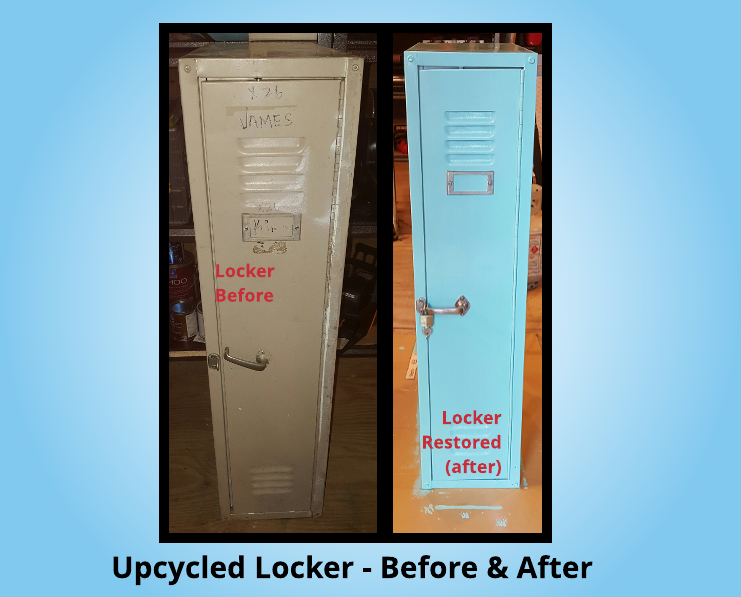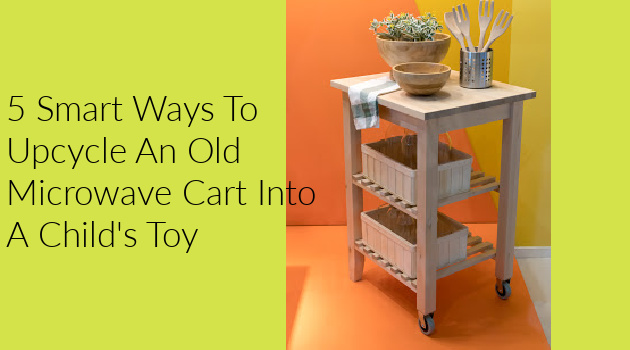Subscribers to DIY Home & Garden are no strangers to the idea of refinishing furniture and upcycling. In fact, many of you have tried ideas that you’ve read here and emailed me photos of your wonderful projects! In fact, some of you have sent me inspirational new ideas that I can’t wait to try out myself!
I’m a huge fan of upcycling, restoring, and recycling! Over the years I’ve been blogging, you’ve seen posts on how to upcycle a ladder into two wonderfully useful items: a trellis and a towel rack. I’ve re-painted an old, discarded bicycle into a planter. Plus, I’ve hauled an old kitchen cart home from the scrap metal pile at the local dump and restored it–by the way, that cart serves as my printer stand in my office to this day.
Still, the problem of where to discard old furnishings is vast. Indeed, the U.S. Environmental Protection Agency (EPA) warns that furniture accounts for over 9 million tons of solid waste in landfills annually. This burgeoning issue requires our attention now more than ever. We must be proactive on this–not just for the sake of our living spaces but for a healthier planet.
The Unseen Problem: The Impact of Furniture Waste
Furniture waste is more than a question of overflowing landfills; it’s an issue that affects every facet of our environment. The production process for new furniture requires significant energy and resources, from harvesting raw materials to transporting the finished product. The result? A substantial carbon footprint before the piece of furniture even reaches your home.
Moreover, much of our discarded furniture is non-biodegradable, taking decades, if not centuries, to decompose. And as it breaks down, it releases harmful gases like methane into the atmosphere, exacerbating climate change.
To bring this closer to home, imagine this scenario: you live in a small town with a population of 10,000, and each household decides to discard an old couch. If every couch goes to the landfill, the resulting pile would not only take up an enormous amount of space but, as they degrade, would emit as much CO2 as burning over 4,000 gallons of gasoline.
Rethink, Reuse, Recycle: Sustainable Solutions to Furniture Waste
Given these startling facts, it’s clear that we need to change our approach to furniture disposal. That is where the concepts of recycling and upcycling come into play.
Benefits of Recycling and Upcycling Furniture to Reduce F-Waste

Recycling and upcycling furniture offer multifaceted benefits, from reducing landfill usage and emissions to creating unique and personalized pieces for your home. Selling creatively upcycled pieces can save you money on new furniture purchases and generate income.
How to Recycle Furniture
Recycling furniture often involves breaking down the piece to its core components and materials. Metals, plastics, and wood can then be separated and reused. Many local waste management services offer furniture recycling, but it’s worth checking in your area. A quick online search should list local recycling centers that accept furniture.
How to Upcycle Furniture
Upcycling, on the other hand, involves taking an existing piece of furniture and transforming it into something new without breaking it down into raw materials. This process is only limited by your creativity. For instance, you can turn an old bed headboard and footboard into a bench for your entryway with a weekend’s worth of time. (Those are all over Pinterest and so lovely!)

Thrifty Treasures: The Beauty of Second-hand Furniture
Opting for second-hand furniture is another fantastic way to minimize your environmental impact. Not only does it prevent usable furniture from heading to landfill, but it also reduces the demand for new furniture production.
Knowing how to shop for second-hand furniture is vital to finding quality pieces. Some great places to start are thrift stores, online marketplaces, or yard sales in your neighborhood. Check the furniture for sturdiness, signs of pests, and whether it comes from a smoke-free home.
Share More, Waste Less: The Power of Furniture Donation
Donating your unwanted furniture extends its life and brings joy to others. Many non-profit organizations are more than happy to take usable furniture off your hands. Some will even arrange for pickup if you have larger items. Not only does this reduce F-Waste, but it also helps those in need. Furniture banks, for instance, help furnish homes for less fortunate families. Before discarding that old coffee table or armchair, consider if it could serve a better purpose elsewhere.
However, before you donate, ensure that the item is in good, usable condition. It’s not a donation if it burdens the receiver to repair or dispose of. Always clean the furniture and ensure it’s free of pests.
Tackling Furniture Waste: It Starts at Home
Change begins at home. By incorporating sustainable practices in our lives, we can each contribute to reducing furniture waste.
Practical tips to reduce furniture waste at home
- Buy Quality, Buy Less: Invest in high-quality furniture that will withstand the test of time,. Thus, it reduces the frequency of replacement.
- Repair and Refurbish: Before discarding a piece of furniture, consider if it can be repaired or refurbished.
- Plan Before You Purchase: Avoid impulse buys. Instead, carefully plan your furniture needs and space.
- Embrace Minimalism: Less is more. By embracing a minimalist lifestyle, you can reduce the furniture you need. Thus, you reduce your potential waste.
- Dispose Responsibly: If you need to remove furniture, ensure you dispose of it responsibly. Use recycling centers, donate, sell, or upcycle.
- Customizable Furniture: Choose furniture that can adapt to your needs over time. For example, some sofas have modular sections that you can rearrange or a dining table that you can slide open with guests.
- Multi-functional Furniture: Opt for items that serve more than one purpose. A sofa bed, for example, can double as a guest bed, and a coffee table with storage can help minimize the need for additional storage furniture.
- Buy Used: Whether from a thrift store, flea market, or online marketplace, buying used furniture reduces the demand for new furniture production, thereby minimizing furniture waste.
- Swap or Borrow: If you need furniture temporarily, consider borrowing from a friend or neighbor. Similarly, physical and online furniture-swapping events are a fun and sustainable way to change up your decor.
- Educate Yourself and Others: Understanding the environmental impact of furniture waste is the first step towards reducing it. Please share your knowledge with friends and family. Perhaps you will inspire them to follow in your footsteps. Every little bit helps in our collective fight against furniture waste.
Role of sustainable living in reducing F-waste
Sustainable living is about more than merely reducing waste—it’s about changing our mindset. When we commit to living sustainably, we inherently reduce our consumption and waste. When applied to furniture, this conscious lifestyle can drastically reduce the amount of Furniture Waste we generate.
Infographic provided courtesy of The Farthing.

The Takeaway: Furniture Waste Is a Problem We Cannot Ignore
Addressing furniture waste is a shared responsibility that begins with understanding the magnitude of the problem and taking personal steps to contribute to the solution. Through recycling, upcycling, buying second-hand, and donating, we can significantly reduce the impact of Furniture Waste on our environment.
Join us for more tips on DIY, home, and healthy lifestyle. By subscribing to our newsletter, you’ll receive regular updates, tips, and success stories from the DIY realm. Stay inspired, stay informed, and be part of a community committed to sustainable living.

